Mexico Cooks! is repeating this post (originally published in January 2010) because World Clown Day's 2013 festival, recently celebrated again in Morelia, is such a lot of fun! Enjoy.

Morelia's well-known Mario Galván is Beto Botones (Bert Buttons). Don't be frightened–these Mexican clowns are completely harmless!
One sunny Saturday not too long ago, Mexico Cooks! hopped into the car and headed for downtown Morelia: it was the annual Día Mundial del Payaso
(World Day of the Clown) and we wanted to see the local clown parade as
it trouped west on Avenida Madero from Plaza Villalongín to the
Cathedral.
Nearly 100 payasos (clowns) form Morelia's
clown community. Entire families, in colorful wigs and ear-to-ear
painted smiles, pass the joy of laughter and delight from one generation
to the next. The patriarch among them is Beto Botones,
personified by Mario Galván. His 23 years as a clown and magician make
him one of the elder statesmen in the Morelia clown community. Now his
sons, 11-year-old Oscar Eduardo (Bombonetto) and 14-year-old Mario
Alberto (Beto Bettín) are also part of the group.
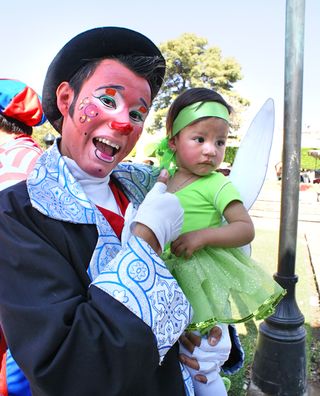
This
beautifully made-up clown has also drawn his family into the act: his
wife and his gorgeous baby daughter have joined the fun. His young wife
said, "Most of the women who are clowns are here because of our
husbands. They were clowns when we married them, so we got involved,
too."
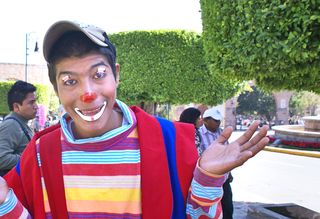
A
relative newcomer to Morelia's clown community. Learning to be a true
clown is a lifetime occupation. Some boys start clowning as early as
age four or five.
There's more to becoming a clown than simply
putting on makeup and a
red nose. For the professional clown, the work of laughter is serious
business. Most attend clown conventions and workshops, where they learn
new routines and participate in competitions. It's not cheap to be a
clown: the right costume and makeup can cost more than 7000 pesos
(approximately $600 USD). Many clowns have a profession in addition to
clowning: Eduaro Espinaza (Tornillito), one of Morelia's most
sought-after clowns, is also an auto mechanic.
Beto Botones said, "In other big cities, a clown can charge 1000 pesos
or more for working a party. Here in Morelia, most charge 600 to 650."
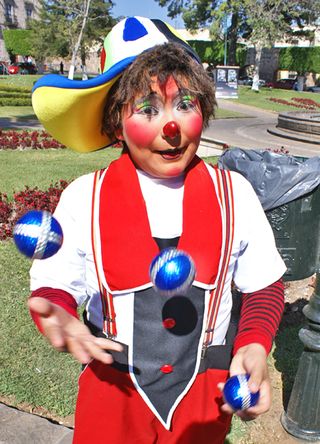
A malabarista (juggler) shows off his skill.
In
the worldwide clown community, there are a number of types of clowns.
Mexico's professional clowns adhere to the same fascinating guidelines.
- CLOWN: he's also known as Carablanca (Whiteface), Pierrot, Enharinado (Flourface)and Listo
(Clever). Normally he's made up in whiteface and wears an elegant,
shiny costume. When there's a clown confrontation among the various
types, he always wins–always! He represents law and order and the
adult world. - AUGUSTO: He's also known as Tonto (the Fool). He's more naive than all the rest and he's always on the receiving end of any joke.
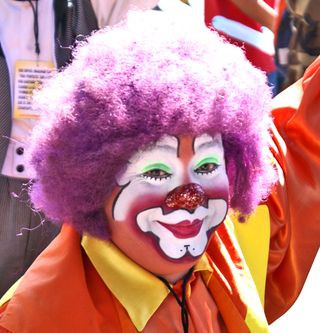
Purple wig, green eye shadow, glittery nose, and orange suit–brilliant!
- SEGUNDO AUGUSTO: He's also known as "Contraugusto" or "Trombo". He's the third figure in a trio of clowns and is often also a musician.
- EXCENTRICO: This clown has evolved from the role of 'Augusto'. He is normally mute and sometimes uses musical instruments or other objects like juggling pins or balls.

Buck teeth, spiky hair, and starry glasses!
- VAGABUNDO (or TRAMP): His character is sad, oppressed, and abandoned.
- PAYASO DE SOIRÉE: This clown is normally an 'augusto'. He acts out his specialty in the entrance to events.
- MIMO-CLOWN: This guy is a variation on the first
clown category. He's usually mute, but he has a lot of tricks up his
sleeve. He can juggle, he's sometimes an acrobat, and he can often play
a musical instrument or two.

Another juggler, in full regalia.
- MESIÉ LOYAL: He's the ringmaster and the director of the show–the ultimate authority.
- CLOWN DE PERSONAJE: We can identify this clown by
his character or profession. He might be a fireman, a sailor, a doctor,
or a cowboy. Or, he might take on the role of a policeman, a child, or
someone from a familiar story.
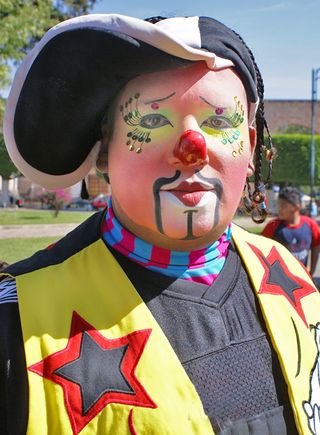
This clown's face makeup is superb. Mexico Cooks! particularly loved his eyelashes and golden tears.
In
addition to this time-honored hierarchy of clowns, Mexico is home to
many informal and little-trained stoplight clowns who work our cities'
street corners. You saw some of them in the January 16, 2009, Mexico Cooks! article Lo Que Se Ve En El Crucero.
Beto Botones said, "These street clowns wear jeans, they don't follow
the norms of real clowns, they think it's too costly to train and work
professionally. But it's important to follow clown traditions. It's
not right that they don't know our history, our theories, and that they
don't want to act like professionals."

The wig! The tongue! The gloves, the shirt, the vest! Who could resist him?
The trained clown always has a red nose, a bright plastic sign that this is a real clown.
His wig can be any color he wants, as long as it goes with his
personality. Today, his makeup is usually airbrushed onto his face in
the style that suits him best. Usually he wears gloves; the "Augusto"
generally uses a dandy's white gloves.

These payasitos–baby clowns–are totally adorable. The little guy on the right sports a wonderful hat.
The
shoes: a clown, especially an "Augusto", is notable for his gigantic,
bulbous, and colorful footwear that serves to call attention to his
character. A clown's suit is almost always copious, with big hidden
pockets filled with balls, juggling pins, hats, and handkerchiefs: the
stuff of magic, jokes, and laughter.
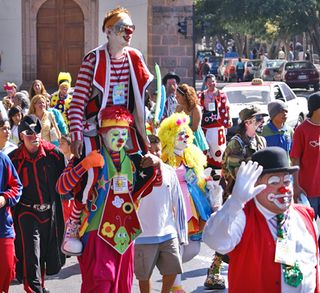
At last, the desfile de payasos (clown parade) turned the corner onto Avenida Madero! Even with the difficult economic situation in today's Mexico, Morelia's payasos haven't lost their sense of humor, their smiles, or their optimism.
Morelia's professional payasos
are available to work all kinds parties and other special events.
Nothing enlivens a child's birthday party like a clown; nothing but a
clown takes a suddenly too-serious event to another level of fun. How
wonderful to know that Mexico's traditional clowns live on for future
generations' laughter.
Looking for a tailored-to-your-interests specialized tour in Mexico? Click here: Tours.
Leave a Reply